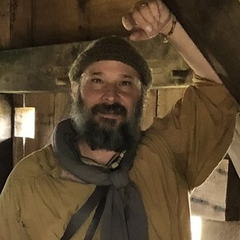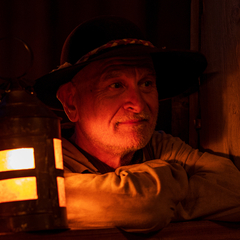-
Posts
2,732 -
Joined
-
Last visited
About michaelsbagley
- Birthday 02/05/1973
Profile Information
-
Gender
Male
-
Location
Columbus, Ohio
-
Interests
I've pretty much "soft" sworn off pirate re-enacting these days. I am DEFINITELY not of a "never again" mindset, but pretty strongly disinclined under most circumstances. But I do miss some of the people. Also, I do mostly still reenact the late 17th/early 18th century timeframe, so feel there is still information to be gleamed/shared from that perspective.
Recent Profile Visitors
-

Making a full kit in four months
michaelsbagley replied to Tudor MercWench Smith's topic in Crafting Kit
"shruggy over pinny bit" = Partlet. While not exclusive to the Dutch or the era, they are extremely common in early to mid-17th century Dutch/Flemish women's working class outfits. In fact in the context I am most familiar with them for (early to mid-17th century Dutch/Flemish), women would often wear a black (wool) one over their bodice, or undergown, then a white linen one on top of the black one (I'm assuming the black was for warmth/comfort, and the linen one for ease of washing/drying) As for dieing on the hill of women in men's shirts. That ignores the two (broad) styles of women's shifts... the off the shoulder type commonly seen with gowns/formal-dresses, and the more working class shifts that were designed for more modesty, and fit over the shoulders and often had men's style collars on them. Thought I'd throw that out to poke the bear. -
I don't know about the provenance of it's use, but the (now defunct) Columbus Santa Maaria reproduction had bagglewrinkle used in many parts.... So not exactly "evidence", but a generally well sourced historical reproduction of a 15th century ship used it.
-

Universe, the Sci-fi RPG goes old school...
michaelsbagley replied to William Brand's topic in Pyrate Pop
Count me in! But to answer the question. None! To make my lame answer better, I have a few pirate themed RPGs ive collected over the years, like I have one that uses the "Savage Worlds" rules engine based on the "Pirates of the Spanish Main" collectable card/mini game. I have a Runequest source book for another. I have "Blood Tides" which uses BRP (same rules under the hood as Call of Cthulhu). And probably another one or two I'm forgetting. I collect more ganes than I actually play. 🤔 But don't get me started on pirate them miniature games... then I might have to write a thesis. -
No need to apologize, it was an easy mistake to do... hell, I am surprised I didn't make the mistake as well... but then I recalled the Ohio River runs through like 6 or 7 states. But in doing a little further digging, the site is pretty remote... like 3ish hours from St.Louis, a similar distance from Louisville, and a lbit more than 2 hours from Nashville.... so remote, with multiple ingress points for those flying.
-
Not to be pedantic.... but this site is in Illinois, on the Ohio River. But that doesn't diminish the point it sounds like a possible fun event. A quick search, and there is a Cave-In-Rock State Park right next to the Cave,... and State Parks tend to be reasonably friendly to reenactors (well more so than the NPS).
-
I try not to get as hung up on specific mixology terms, as I am only an amatuer. I mean there is a couple of YooHooToob channels on mixology I follow, and I've picked up some of the terms, and try to use them when I can, but I am no where near pedant level in that skillset yet! But I agree with Jill, anything with Blueberries is devine
-
Dude, it sounds like a dream of a beverage... but also something when imbibe to excess has the effects of diminished memory. It also sounds like something that could be improved upon (method-wise, not taste). Im thinking of a concoction where the spices, sugar, and raisins are steeped in boiling water to make a syrup. That way you could carefully measure the amount of said flavourants, and more easily reproduce it in the future. Also, you'll burn through less rum finessing a syrup to recreate it than you would trying your previous method. You can likely taste just the syrup on its own for tweaks and adjustments.
-

Pyracy Gaming at Origins Game Fair - Columbus, OH
michaelsbagley commented on madPete's event in Community Calendar
- 12 comments
-
Welcome to the madness. It was great meeting you last weekend
-

Pyracy Gaming at Origins Game Fair - Columbus, OH
michaelsbagley commented on madPete's event in Community Calendar
until
The Pyracy pub gang at Origins, Mary, William, Kate, and Mickey- 12 comments
-

Gonna Ressurect Gentlemenoffortune.com... somehow.
michaelsbagley replied to Gentleman of Fortune's topic in Captain Twill
It's like necromancer, the dead are all rising again. -
Welcome back! I recall your very thoughtful questions from the old days. Good to see you again.
-

The Traveling Yard 2023 - Information and Sign Ups
michaelsbagley replied to Duchess's topic in Arts of Pyracy
I have these two blocks (they belong to wife from a time she dabbled in block printing fabric scarfs)... they've gone unused for a handful of years or more. I'd happily contribute these to the effort. I also distinctly recall there being 3 or 4 of them, but this is all i could find for now. If I recall, they were purchase at one of the big hobby store chains, but sadly I think the one that is currently going out of business. -

The Traveling Yard 2023 - Information and Sign Ups
michaelsbagley replied to Duchess's topic in Arts of Pyracy
I too would be very excited about a 2nd adventure of this type... Short story time. I have used mine a lot. Maybe not soo much that it faded or was heavily worn or frayed in the year and half since this came together. But I used it a fair bit. This past weekend, I traveled to California, with my traveling yard. I was attending one of those big all-day festival concerts. I wore my traveling yard as an accessory. And through the course of the day, it came loose, and was lost in the crowd. Likely while I was watching the Buzzcocks, but perhaps someone else. I was pretty dissapointed in myself when I noticed it's absence. I am guessing I didn;t knot it tightly enough... So yeah, please, let's do this again. -
It brings me great joy to see the bale mark passed around and used in different manners.









until